Project Six - The Capuchin Sundial
8. Draw a line AF 23.5º upwards from AE and a line AG 23.5º downwards from AE. The point F corresponds to the summer solstice and the point G corresponds to the winter solstice.
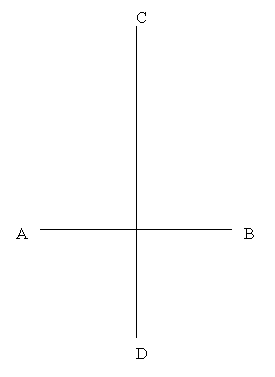

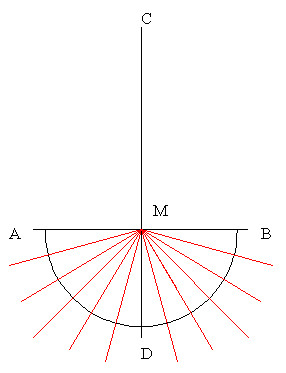
1. Draw a horizontal line AB, approximately as long as the intended width of the sundial.2. Draw a line CD perpendicular to the horizontal line, crossing it at the middle.
3. Draw a semicircle downwards with one point of the protractor in M, where the lines are crossing.
4. Divide the semicircle in 12 parts. Every part will be 15º.
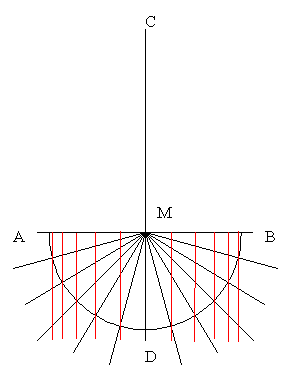
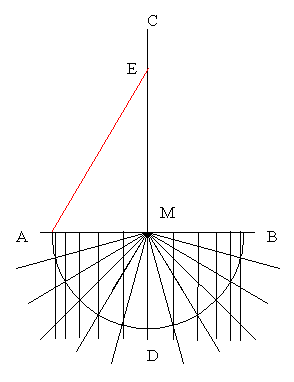
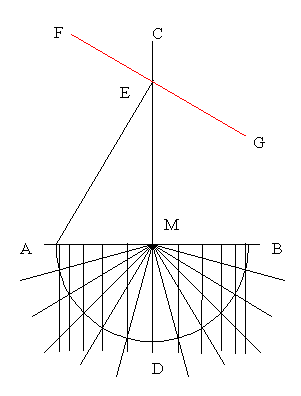
5. Draw vertical lines parallel to the vertical line CE, between the semicircle and the diameter. These lines will be the hour lines of the sundial.
6. Draw a line AE from A, with an angle BAE equal to the latitude of the place you want to use the sundial.
7. At the point E, draw a line FG perpendicular to the line AE. This will be the date line of the sundial. Later you will cut through this line to fix a plumb line in the slot. The point E corresponds to the spring and autumn equinoxes.
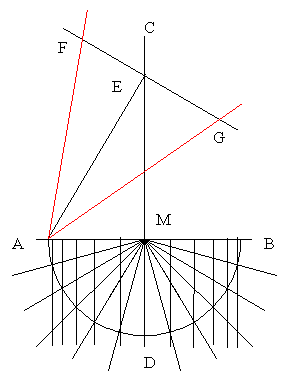
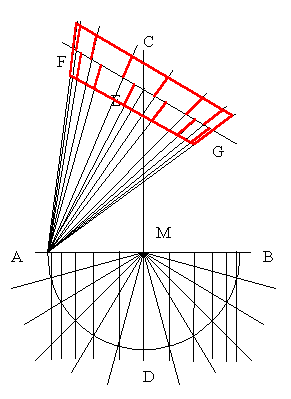
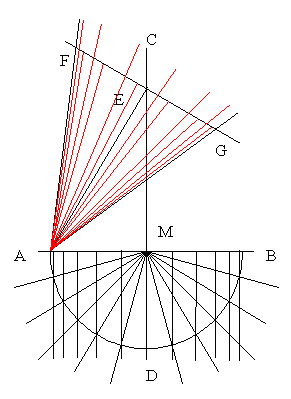
Project 6. The Capuchin Sundial
This project was produced by Anders Bergström and originally published in Swedish on his website. He very kindly provided this English translation.
If you want to print out this project by itself, it will shortly be available on a separate page
This is a description of the design of a portable sundial. It is also known as a Capuchin sundial, named after the Capuchin monks, who belonged to a branch of the Roman Catholic Order of Franciscans. They wore a hood, that resembled the face of the sundial.
The simplest way to build the sundial is to use a piece of cardboard. Draw construction lines according to the description below. It is also possible to use a more durable material, such as a sheet of brass or similar.
9. Mark the declination of the sun, for the first day of every month in the first half year, above the line FG. In a similar way, mark the declination of the sun, for the second half year, below the line FG.
10. What remains is to tidy up the dial. Draw a scale for the months around the line FG
The table below lists the declination of the sun for the first day of each month. All angels are set from the line AE, corresponding to the equinoxes. Positive angles are marked clockwise from AE and negative angles are marked anti-clockwise from AE.
Table: Sun's Declination at the First Day of Every Month
Jan Feb Mar Apr May Jun
Dec Nov Oct Sep Aug Jul
-23º -22º -17.5º-14.5º-7.5º-3º+4.5º+8º+15º+18º +22º +23º
16. What remains is to cut out the sundial and cut a slot in one corner, for the sun to shine through. You also have to draw a straight line, parallel to the old AB, from the slot to the other side of the sundial. Make a cut below the slot so you will get a flap to fold up. 17. Get a cotton thread with a small weight and a small pearl which can slide up and down the thread. Insert the thread in the slot cut out in step 11, fix a small button on the back side to make it possible to slide the thread up and down along the slot.
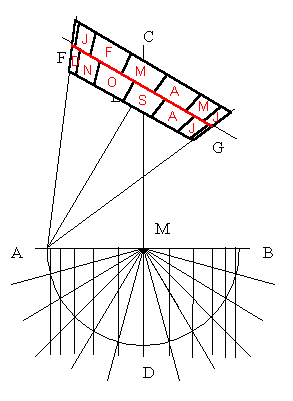
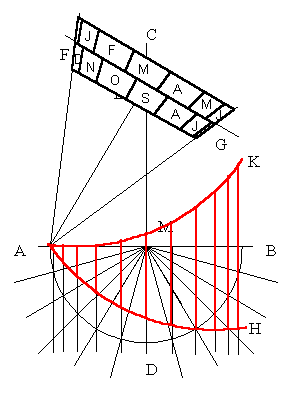
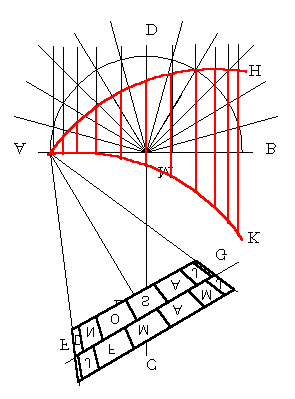
11. Remove unnecesary construction lines around the scale and write the name of the months on the scale. Make a cut along the line FG.
12. Put one point of the protractor at G and draw an arc AH. This is the timeline for the summer solstice.
13. Put one point of the protractor at F and draw a second arc AK, forming the timeline for the winter solstice.
14. Extend the construction lines in step 5 between the two arcs.
If you turn the sundial upside down, the two arcs looks like the hood of the Capuchin monks. This is why it is called a Capuchin sundial.
15. The final touch-up is to remove all construction lines. You can also write the hours on the scale and draw an arc through A with the equinox point E as center.
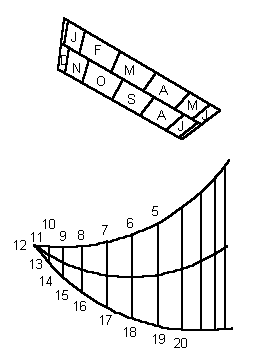
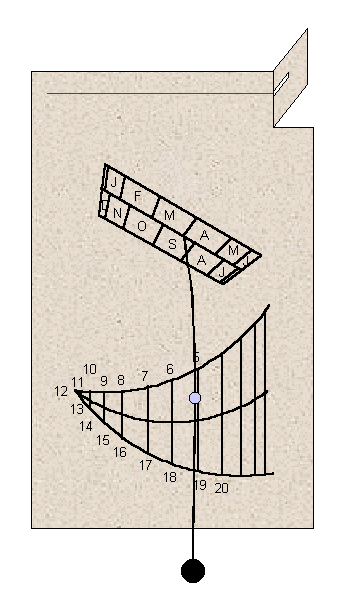
Calibrating the Sundial
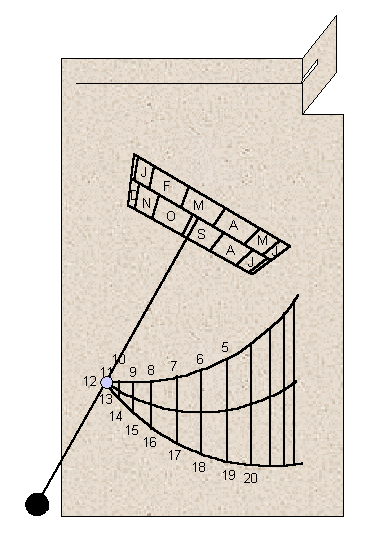
Calibrate the sundial by moving the thread to current date. Then align the thread with the tip of the "hood" and move the pearl to the tip ("Twelve noon").
Using the Sundial
Hold your sundial vertically and let the sun shine through the slot. Incline the sundial until the sun beam is parallel to the line across the upper part. The thread will now indicate the plumb line, if you take care that it does not touch the dial. The pearl will indicate the time of the day. This example shows the time as a quarter past eight in the morning or a quarter to four in the afternoon. Unfortunately, you have to keep track of, if it is a.m. or p.m. yourself.
The sundial shows local (true) solar time. In Sweden we use a standard time that is the mean solar time at the longitude 15º east of Greenwich. It corresponds to the longitude of the city of Orebro in the middle of Sweden. Stockholm is situated a further 3º to the east, which corresponds to 12 minutes earlier than the standard time. If the time had been observed in Stockholm, it would rather correspond to eight sharp Swedish time in this example. If it had not been during the daylight saving period of course, but sundials are not designed for such modern inventions. The same observation in Gothenburg would correspond to close to half past eight Swedish time, because Gothenburg is 3º west of longitude 15º. The difference in solar time between Stockholm and Gothenburg is 24 minutes!
To make things further complicated, the earth does not rotate at the same speed around the year. The earth travels in an elliptical orbit around the sun and speeds up or slows down depending on the distance to the sun. The sundial only shows "correct" time, that is Clock Time only four times a year, in the middle of April, the middle of June, the beginning of September and around Christmas. Other periods during the year the fault can be more than 15 minutes, forwards or backwards. The phenomena is called "Equation of Time" and is usually found in tables in astronomical almanacs.
